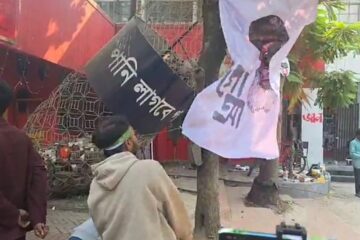Even after 53 years of independence, a two-kilometer stretch of the Swalpo Mohora–Jamurki road in Mirzapur upazila of Tangail remains unpaved, causing immense suffering to more than one hundred thousand people across three upazilas.
The condition worsens significantly during the monsoon, prompting locals to demand immediate road construction.
According to local sources, the road was built before the British colonial period but has not seen any development since the country’s independence.
Despite repeated promises by successive governments and local leaders, no visible improvement has been made.
The Mahera Jomidar Bari, a historic architectural landmark in Mirzapur, was established in the 1890s and later converted into the Police Training Centre (PTC) in 1972.
This is the only route connecting Mirzapur, Basail, and Delduar upazilas to the PTC.
However, due to the road’s dilapidated state, it has become nearly impassable, especially during the rainy season.
Locals allege that despite the road’s significance, no government has taken steps for its development.
The Mahera Jomidar Bari, known for its exquisite architecture, attracts hundreds of visitors daily from across the country.
Because of the road’s poor condition, both locals and visitors are forced to take a five-kilometer detour to reach the site.

Residents of Koraile, Bhatkura, Chaulimohora, Adabari, Jamurki, Goran, Satiachara, Ganutia, Dhallya, and Baniara villages depend on this road for daily travel.
Locals said it is also the main route for residents of three upazilas- Basail, Delduar, and Mirzapur—to reach the Jamurki market and the local health complex.
However, the road’s condition has deteriorated so much that people have almost stopped using it.
Transporting patients has become extremely difficult, and the area’s socio-economic progress has been hindered as a result.
Several educational institutions are located along this route, including Swalpo Mohora Government Primary School, Hafizia and Ebtedayee Madrasas, Gobra Grambangla Technical College, Mahera Anand High School, Chauli Bhatkura Achham Begum Kundeshwari Girls’ School, Jamurki Government Primary School, Jamurki Nawab Sir Abdul Gani Multipurpose High School, and Dubail Hafizia Madrasa and Orphanage.
Thousands of students face daily difficulties traveling through the muddy, broken road.
Rickshaw-puller Nuru Mia said he has to use this road every day, and the condition becomes unbearable during the rainy season.
“It’s even harder when the vehicle is empty, as we need help from others to push it through the mud. I spend more on repairs than what I earn,” he said. “We’ve seen this road in the same condition since my grandfather’s time. All we want is for the government to finally pave it,” he added.
Gazi Fahim and Ahed, eighth-grade students at Star Academy School, said: “Our school has about 700–800 students, and many of us use this road. During the rainy season, it becomes almost impossible to walk. If we take the alternative route, it adds five kilometers, and we can’t reach school on time.”
Sadek Ali Mia, head teacher of Jamurki Nawab Sir Abdul Gani Multipurpose High School, said: “I was born in this village and have seen no development on this road in my lifetime. People from three upazilas use it for education, agriculture, and daily travel. Even a little rain turns it into a muddy swamp. Students suffer the most trying to reach school.”
When contacted, Mohammad Kamruzzaman, executive engineer of Tangail LGED, said: “The unpaved two-kilometer section of the Swalpo Mohora–Jamurki road in Mirzapur has been listed under the LGED’s ID system. The DPP process is underway, and we expect the road’s paving work to be implemented soon under the DPP project.”



